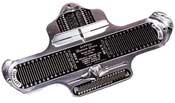Measure Your Foot Properly!
Knowing how to measure your foot
properly is one of the most important and least understood parts of good shoe fit.
You may have read about drawing an outlined of
your foot on a piece of paper and measuring the dimensions on the paper.
This is one way to measure your foot in a pinch and can get you close. It does have a few limitations though.
If you want to be totally certain of all your foot measurements there is ...
A Better Way
Start by finding a knowledgeable sales person in a reputable shoe store to measure your foot using a Brannock Device. Better shoes stores should have them. Your salesperson should be properly trained in how to use it.
This device was invented by Charles Brannock in Syracuse, NY over 80 years ago. He was passionate about finding the best way to measure foot he could. The fact that it is still manufactured and used today is a testimony to the great job he did.
A Mini Tutorial
- so you can make sure the sales person is doing her job well!
NOTE: this gets a bit technical. Read though it once though and you'll have a full understanding of what to do and why.
Stand with your feet spread about walking width and weight spread evenly. You want to make sure that your feet are elongated and spread as far as they do when you walk. They do change shape and size when you have weight on the!
IMPORTANT: you need to be standing while you are taking these measurements!
Wear the socks you plan to wear with the shoe your shopping for. Make sure your socks fits properly with no toe or heel slack. You're measuring your foot here, not extra sock material!
And if you plan to wear your new shoes without socks, then measure them without socks.
When you measure your foot you need to get ...
Three Separate Measurements
- Heel to longest toe length
- Heel to ball length (arch length)
- Foot width
1. Heel To Toe Length
Place your heel snugly in the correct cup of the device. There's a different one for each foot. Note the size marking closest to the longest toe. Do NOT add another half or full size to this number. Toe room allowance is already built into the shoe itself - usually 3/8"-1/2".
2. Heel To Ball (Arch) Length
This is THE most important shoe fit criteria. It matches shoe flex to foot flex. It also fits the widest part of the foot with the widest part of the shoe. When you do this correctly, you will really notice the difference when you're walking, NOT when you are standing still in the store.
With your heel snugly in the correct cup, position the concave slider on the inside of your foot so that the ball joint (bump behind your big toe) fits snugly into it. Note the size on that scale. This shoe size may or may not be the same as the shoe size indicated by your heel to toe length. Confused? Read on!
Differences in your heel-to-toe length and heel-to-arch length size are basically an indicator of whether you have longer or shorter toes than the average. If there is less than a 1/2 size difference between the two measures then you should try the heel-to-ball shoe size on first.
In cases where there is more than one size difference between these two measurements then split the difference. Start with that shoe size. Were trying to match the widest part of your foot with the widest part of the shoe - which just happens to be where the shoe flexes! So let's finish with...
3. Foot Width
...the final measurement! With your heel snug in the correct cup and the ball snug in the concave slider, move the width slider against the outside of the foot. Here you have to find the shoe size from the previous step on the scale, not the next one to find the correct width.
In cases where there is a big difference between your heel-to-toe and heel-to-arch measurement you should compromise between the two measurements and see if a shoe with a longer vamp (ball to toe) length is available.
What Next?
Now you're ready to START fitting shoes. We suggest you work though THAT process here.
There are just so many variations in feet, it's impossible for manufacturers to exactly match each and every variation.
You have to try them out. You be the judge. You'll be very close and might just need a wee bit of fine tuning.
Feet can be higher above the arch than normal, may have differences in heel size, really long toes, have more volume. Sometimes you may need a slightly wider, narrower or different size shoe than the numbers tell you. In a lot of cases these 'unique' fit issues can be easily handled.
This is where a knowledgeable sales person can be worth her weight in
gold. We suggest you not settle for less. They are your feet and your happiness is on the line.
You can get a few more ideas on how to handle 'unique fit' issues in our Shoe Lacing Techniques section. Check it out.
Great good luck on your quest. You can do it!
Top of Measure Your Foot Properly!
Return To 4 Steps To A Successful Shoe Fit)
Share this page with your friends by clicking our "LIKE" button below. Thanks for sharing!
|
Start your program NOW!
|
Check This Out!
Another Rewarding Way
To Spend Your Time
Between Walks!

Stay Informed!
Subscribe To Our FREE Newsletter Today!







New! Comments
Have your say about what you've just read! Leave us your comment in the box below.